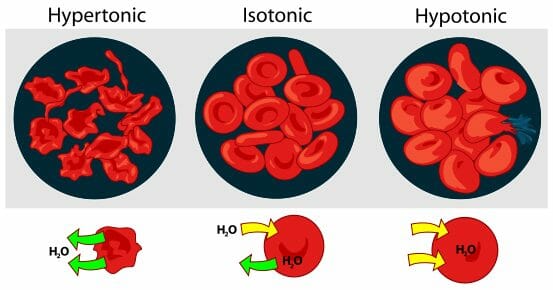Isotonic Solution Definition
An isotonic solution is one that has the same osmolarity, or solute concentration, as another solution. If these two solutions are separated by a semipermeable membrane, water will flow in equal parts out of each solution and into the other. The effect is zero water flow between the two solutions, although water is moving both ways. In biology, some cells must be maintained in an isotonic solution to support cellular functions. Many animal cells, which lack a cell wall to provide support against the effects of water pressure, rely on the stability of the external environment to maintain their shape. Most animals maintain the pH and osmolarity of the fluids inside of their bodies to create isotonic solutions to bathe their cells in. This solution can carry nutrients and water, but only in proportions equal to that inside the cell.
A depiction of a cell in an isotonic solution can be seen above. Note that because there is the same concentration of solute molecules inside and outside of the cell that water molecules are simply exchanged through the cell membrane. This can be contrasted to the effects of a hypertonic solution, in which water molecules leave the cell, or a hypotonic solution in which water enters the cell.
Examples of Isotonic Solution
Blood Cells
When the plasma surrounding blood cells is an isotonic solution, compared to the solution inside the blood cells, the cells function normally. The isotonic solution allow the cells to move water and nutrients in and out of the cells. This is necessary for blood cells to perform their function of delivering oxygen and other nutrients to other parts of the body. If the cells are in a hypertonic environment, they will become plasmolyzed and will not contain enough water to perform cellular functions. If the cells exist in a hypotonic environment, they will lyse, spilling their contents into the bloodstream. This can cause dangerous side effects, as well as the loss of many blood cells. These events can be seen in the graphic below.
To avoid either of the negative situations from happening during the transfusion of nutrients and medicine, the solution that carries the medicine must be an isotonic solution, compared to the patient’s blood. The osmolarity of the IV fluid can be adjusted using special salts and sugars that act simply as solutes to dilute or strengthen a substance. Once a medicine is an isotonic solution compared to the blood, it can be added through an IV and no damage will occur to blood cells.
Osmoconformers and Osmoregulators
In nature, there are two types of organisms: those who conform to the osmolarity of the environment, and those that regulate the osmolarity of their body to be different from the environment. The first are known as osmoconformers and have evolved to have cells that match the osmolarity of the environment. These animals always exist in an isotonic solution, because they have evolved to be the same concentration as the environment. This condition can be seen in many of the “lower” forms of life such as the sea slugs, coral, and jellyfish. The other group, the osmoregulators, do not exist in an isotonic environment. This means that water tends to want to enter or leave their bodies, and they have various methods for dealing with this. However, inside of an osmoregulators, the cells will still exist in an isotonic solution, as the organism needs its cells to remain functions. Both osmoregulators and osmoconformers have different benefits for conducting life the way they do, but an isotonic solution is usually created around cells.
Related Biology Terms
- Hypotonic – When a solution has comparatively more water and less solute.
- Hypertonic – A solution with less water and more solute than another solution.
- Osmolarity – The overall solute concentration of a solution.
Quiz
1. A cell has a concentration of 10 g/L. The surrounding environment has a concentration of 10 g/L. Which of the following is true?
A. The cell exists in an isotonic solution; no water will flow.
B. The cell exists in an isotonic solution; water will flow both into and out of the cell.
C. The cell exists in a hypertonic environment; water will flow out of the cell.
2. Plant cells rely on the turgidity of their cells, or the water pressure inside, to maintain their shape. What happens to a plant cell when placed in an isotonic solution?
A. It remains turgid and can function
B. It loses all its pressure and cannot function
C. It becomes flaccid, but can still function
3. A student is trying to create a solution that is isotonic to the cells being cultured. It is known that the concentration of the cytosol in the cells is 1 g/mL. The student has 2 liters of water to create a nutrient solution. Which of the following would create an isotonic solution for the cells?
A. Adding 2 grams of solute
B. Adding 1000 grams of solute
C. Adding 2000 grams of solute


